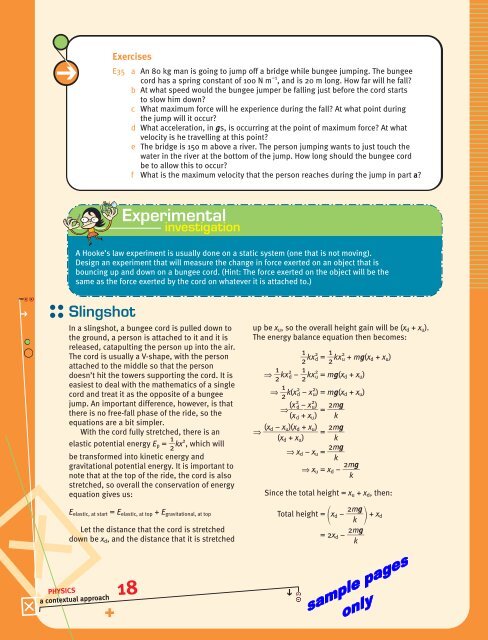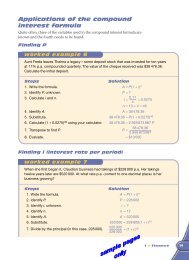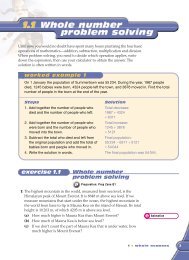Context 1: Amusement Park Physics - hi.com.au
Context 1: Amusement Park Physics - hi.com.au
Context 1: Amusement Park Physics - hi.com.au
You also want an ePaper? Increase the reach of your titles
YUMPU automatically turns print PDFs into web optimized ePapers that Google loves.
⌧<br />
<br />
➔<br />
➔ Slingshot<br />
In a slingshot, a bungee cord is pulled down to<br />
the ground, a person is attached to it and it is<br />
released, catapulting the person up into the air.<br />
The cord is usually a V-shape, with the person<br />
attached to the middle so that the person<br />
doesn’t <strong>hi</strong>t the towers supporting the cord. It is<br />
easiest to deal with the mathematics of a single<br />
cord and treat it as the opposite of a bungee<br />
jump. An important difference, however, is that<br />
there is no free-fall phase of the ride, so the<br />
equations are a bit simpler.<br />
With the cord fully stretched, there is an<br />
1 2<br />
elastic potential energy Ep = kx , w<strong>hi</strong>ch will<br />
2<br />
be transformed into kinetic energy and<br />
gravitational potential energy. It is important to<br />
note that at the top of the ride, the cord is also<br />
stretched, so overall the conservation of energy<br />
equation gives us:<br />
Eelastic, at start = Eelastic, at top + Egravitational, at top<br />
Let the distance that the cord is stretched<br />
down be xd, and the distance that it is stretched<br />
PHYSICS<br />
a contextual approach<br />
✚<br />
Exercises<br />
E35 a An 80 kg man is going to jump off a bridge w<strong>hi</strong>le bungee jumping. The bungee<br />
cord has a spring constant of 100 N m –1 , and is 20 m long. How far will he fall?<br />
b At what speed would the bungee jumper be falling just before the cord starts<br />
to slow <strong>hi</strong>m down?<br />
c What maximum force will he experience during the fall? At what point during<br />
the jump will it occur?<br />
d What acceleration, in gs, is occurring at the point of maximum force? At what<br />
velocity is he travelling at t<strong>hi</strong>s point?<br />
e The bridge is 150 m above a river. The person jumping wants to just touch the<br />
water in the river at the bottom of the jump. How long should the bungee cord<br />
be to allow t<strong>hi</strong>s to occur?<br />
f What is the maximum velocity that the person reaches during the jump in part a?<br />
Experimental<br />
investigation<br />
A Hooke’s law experiment is usually done on a static system (one that is not moving).<br />
Design an experiment that will measure the change in force exerted on an object that is<br />
bouncing up and down on a bungee cord. (Hint: The force exerted on the object will be the<br />
same as the force exerted by the cord on whatever it is attached to.)<br />
18<br />
up be xu, so the overall height gain will be (xd + xu).<br />
The energy balance equation then be<strong>com</strong>es:<br />
1 2 1 2<br />
kxd = kxu + mg(xd + xu)<br />
2 2<br />
1 2 1 2<br />
⇒ kxd – kxu = mg(xd + xu)<br />
2 2<br />
1 2<br />
⇒ k(xd – x<br />
2<br />
2 u) = mg(xd + xu)<br />
⇒ (<br />
2 2<br />
x d – xu)<br />
= <br />
( xd<br />
+ xu)<br />
2mg<br />
<br />
k<br />
⇒ (xd – xu)<br />
(xd<br />
+ xu)<br />
= <br />
(xd<br />
+ xu)<br />
2mg<br />
<br />
k<br />
⇒ xd – xu = 2mg<br />
<br />
k<br />
⇒ xu = xd – 2mg<br />
<br />
k<br />
Since the total height = xu + xd, then:<br />
Total height = xd – 2mg<br />
<br />
k + xd<br />
= 2xd – 2mg<br />
<br />
k<br />
<br />
➔

















